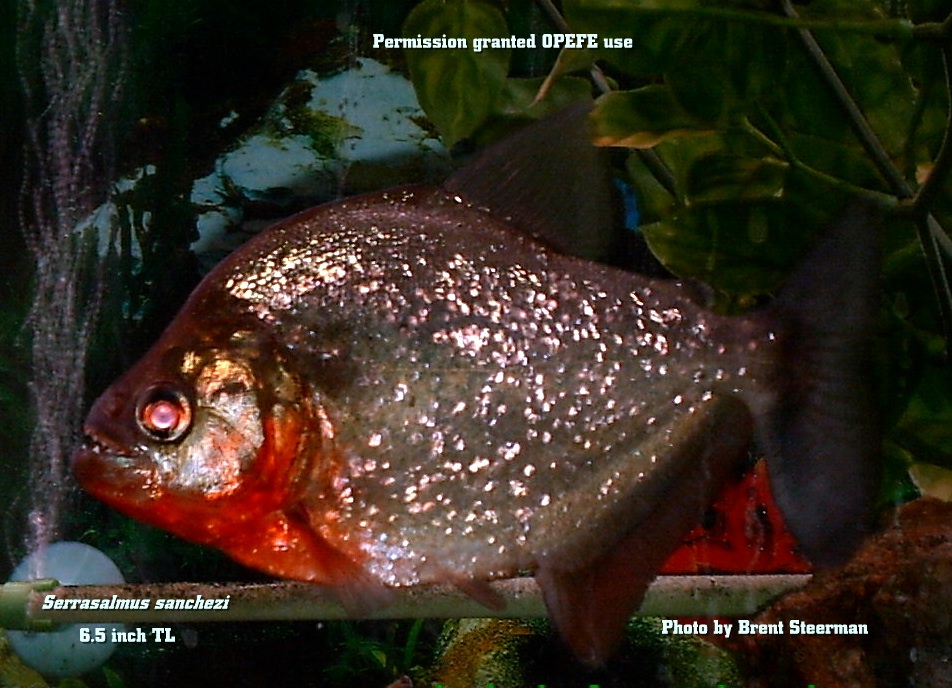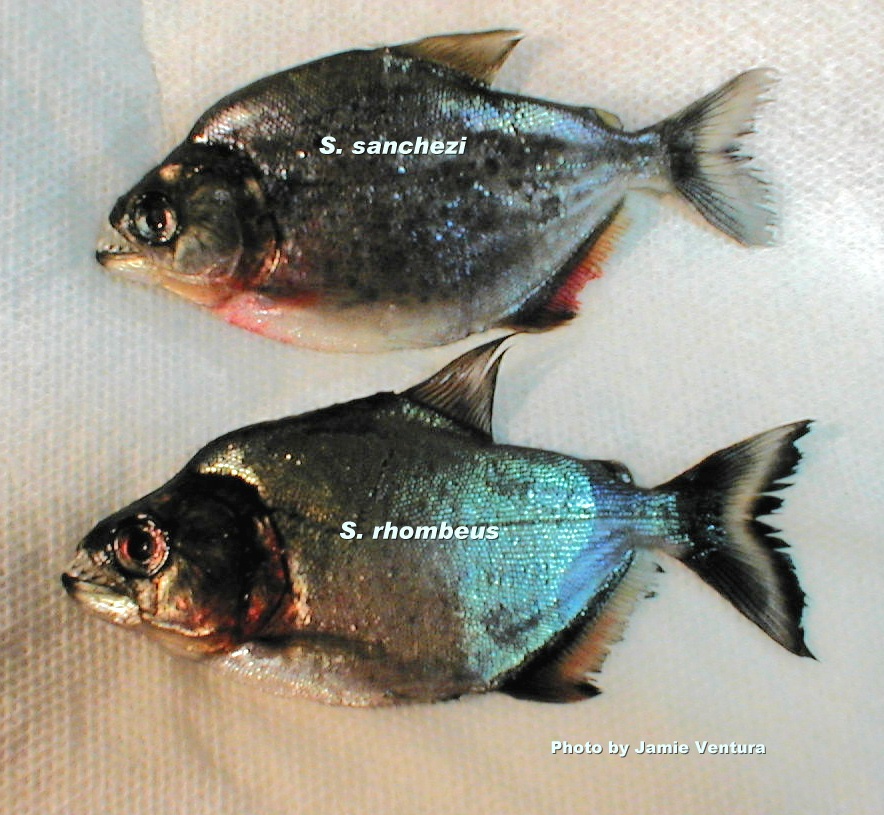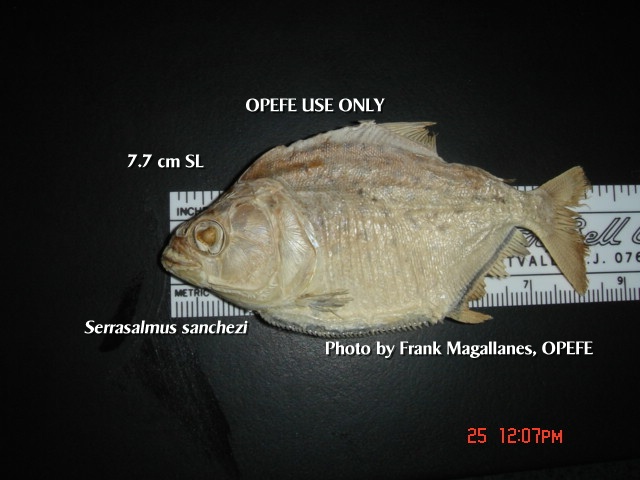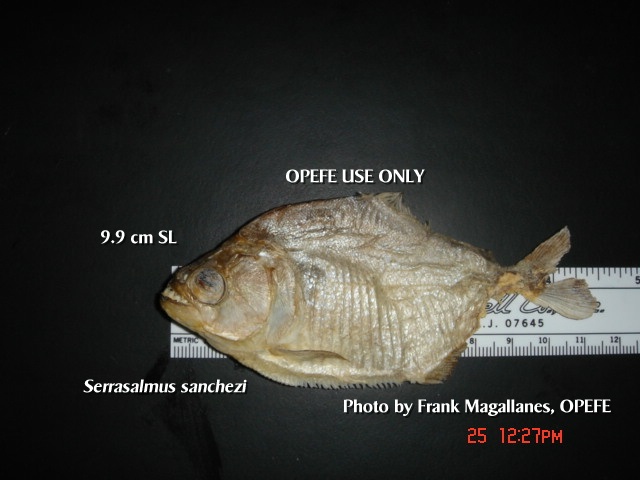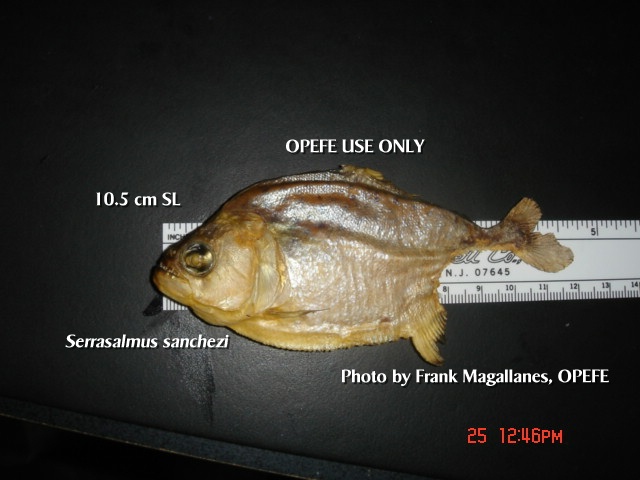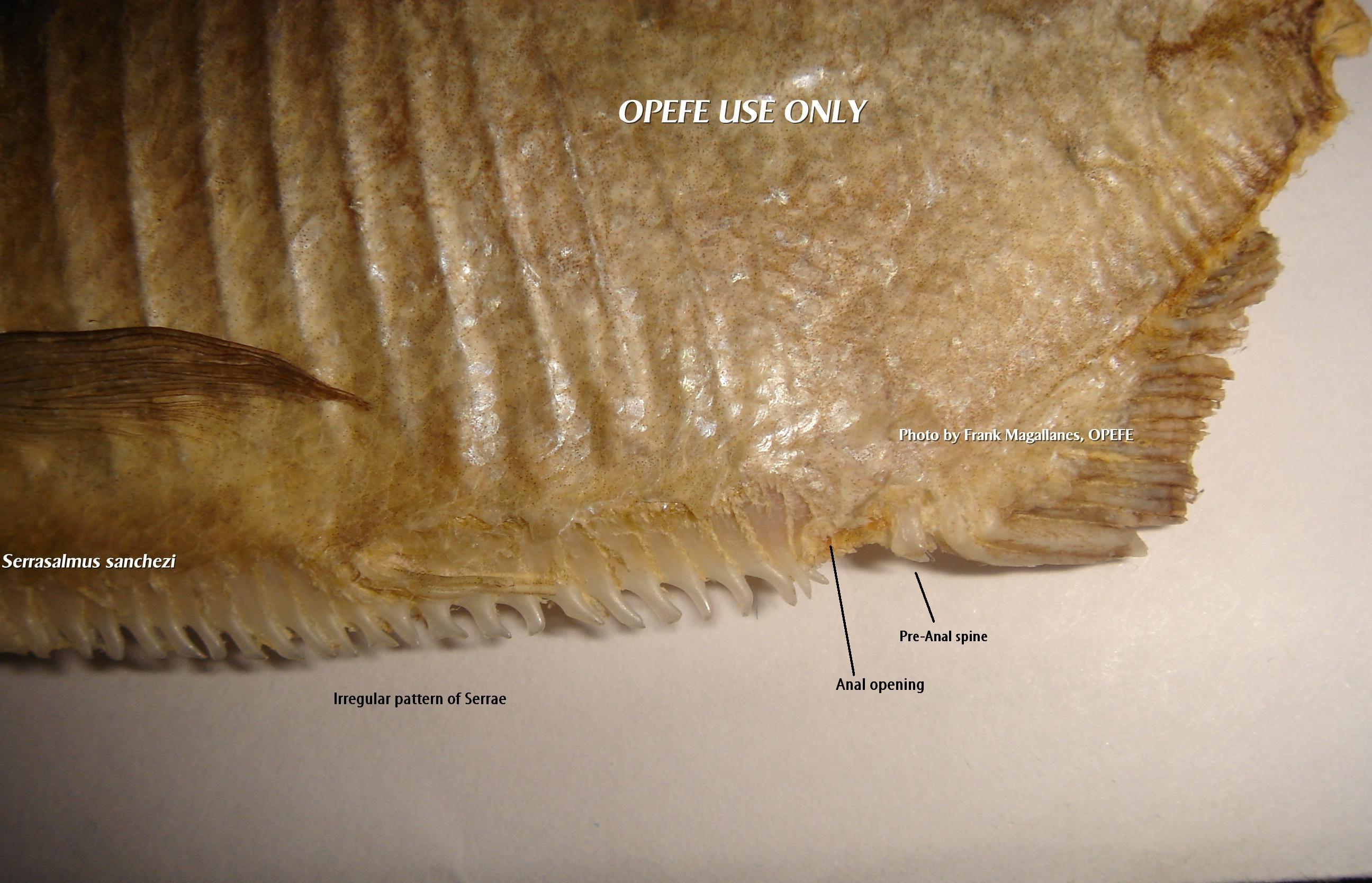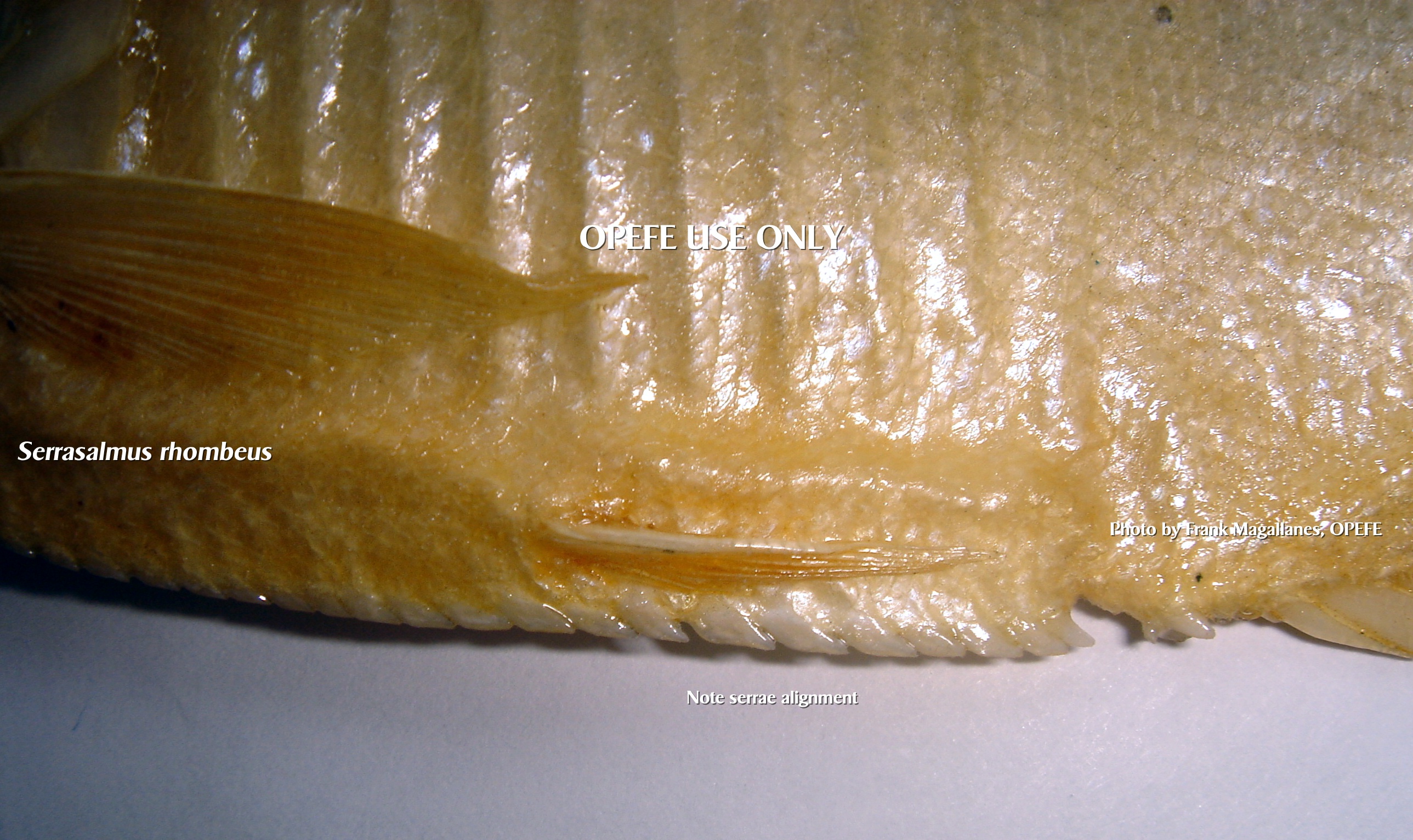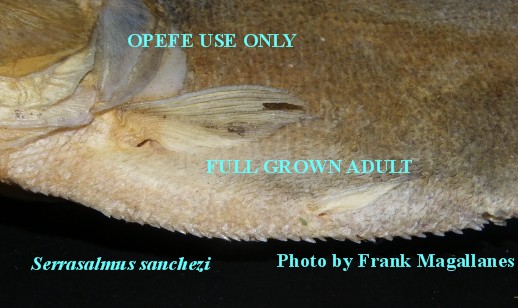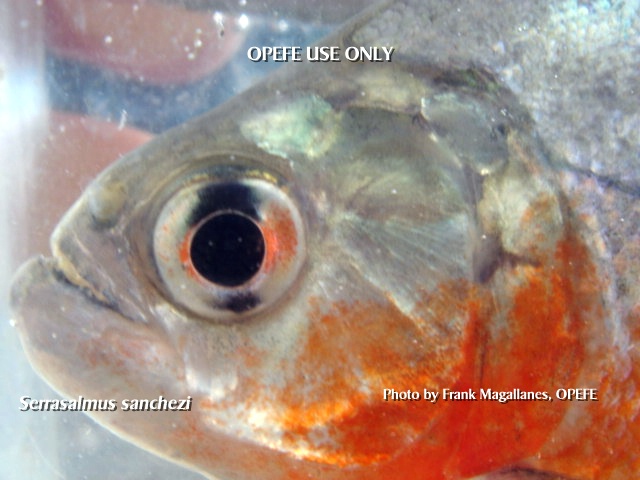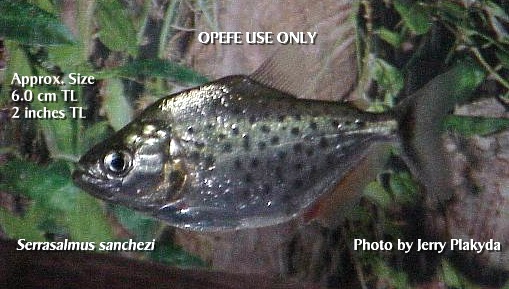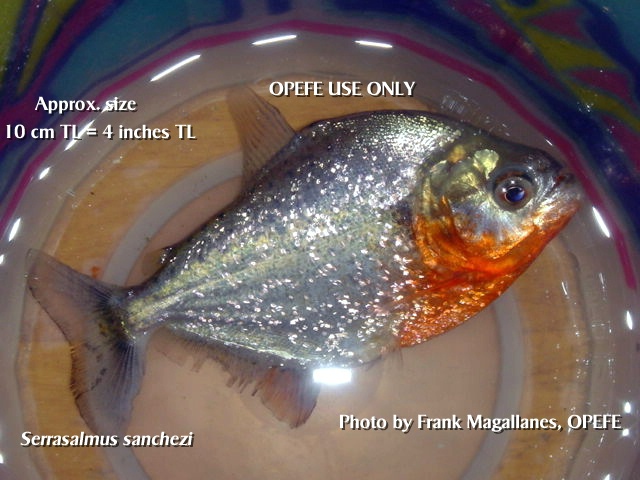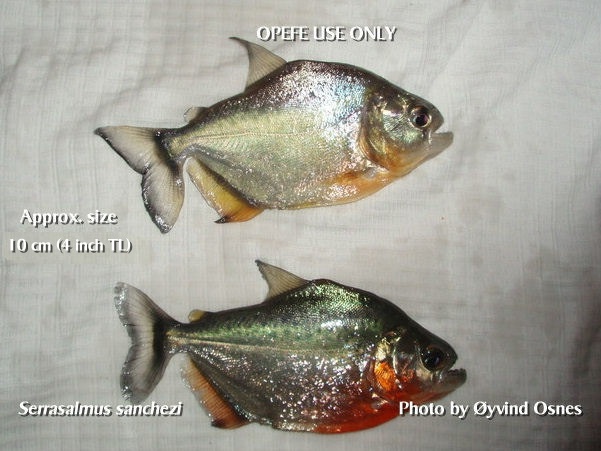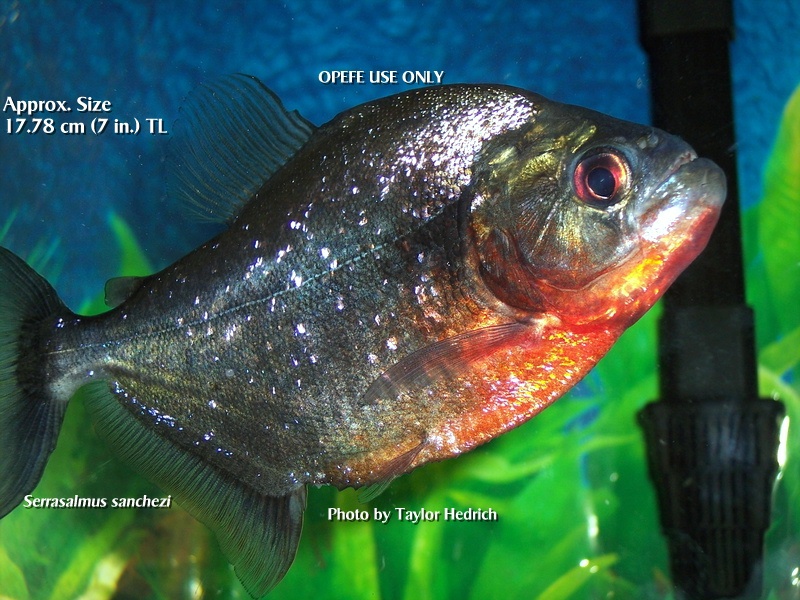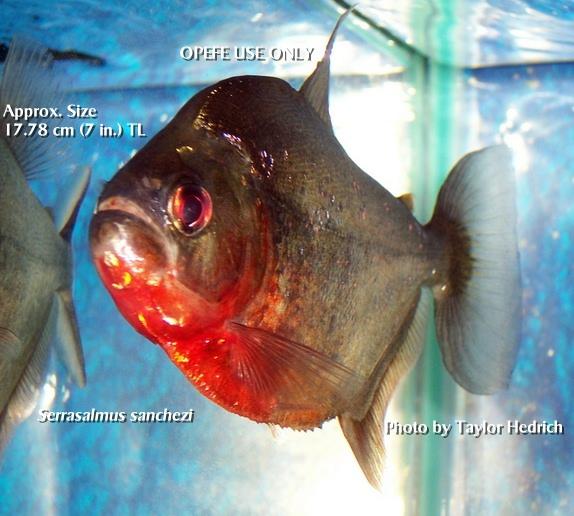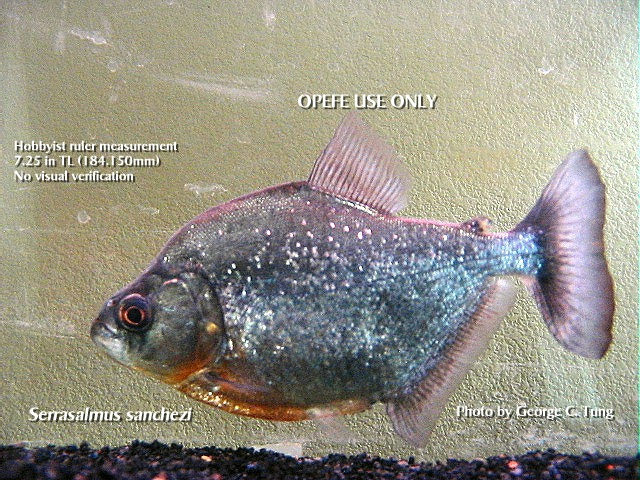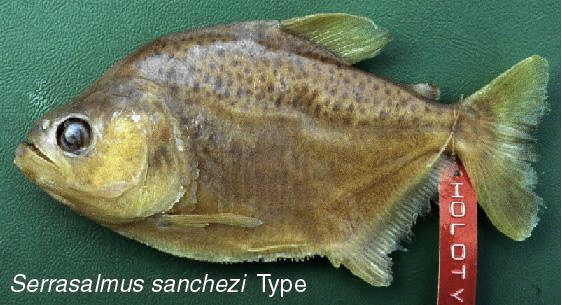SANCHEZ PIRANHA, RED SNAPPING TETRA, RUBY-RED DIAMOND PIRANHA OR RUBY RED SANCHEZI
Serrasalmus sanchezi
G?ry 1964
Peru, Rio Ucayali
FROM FRANK MAGALLANES
I first saw this species in 1957 captioned as S. spilopleura at a public aquarium and then again in a pet store (1966), two (2) year's after it was first described. Photo's displayed here are representative of a live S. sanchezi and should not be construed that it is S. sanchezi. Reader's should refer to the actual description and accompanied photograph by G?ry, 1964 citation (see below). Often sold under the common name of Spilo CF, it is also often mistaken as S. medinai by hobbyists unfamiliar with the differences. See all S. iridopsis.
UPDATE - October 25, 2011
See Serrasalmus odyssei VIEW
SPILOPLEURA COMPLEX VS RHOMBEUS GROUP
The species is not a spilopleura complex member and is member of the group that is part of the rhombeus complex of species as determined by G?ry 1964. The tail fin is continuously bit by other piranhas giving it a mid-band appearance on the tail. It is for this reason the fish was misidentified by publications as a S. spilopleura or in worst cases P. nattereri. The original common name red-snapping tetra was coined by Woody Trout in 1966. I believe the name was more in keeping California Fish and Game officials from confiscating the fishes from his store. A more appropriate common name and my suggestion is ruby red diamond piranha. Both fishes seen in 1957 and 1966, were approximately 6 inches TL. In the case of the fish in the dealers tank (circa 1966) store owner and biologist Woody Trout informed me the fish was S. sanchezi. The fish at the Monterey Bay Aquarium carried the name S. spilopleura but according to Bill Hyler, this fish is identical to this one shown and the same displayed at the Monterey Bay Aquarium (circa 1957). So either way, this fish has been around for some time and misidentified in most cases in what has been previously published. S. sanchezi may also be more closely related to S. irritans (Venezuela). Both species share similar morphological appearances. But it will take DNA and a review by a competent authority to validate both species relationship (if any) with each other. According to George Fear, this species is fairly common in Iguitos, Peru, Rio Itaya.
Readers are cautioned that S. sanchezi is still relatively unknown species and Michel J?gu is reviewing the species. The only comparison done in 1964 were those species looking similar to this one in particular, Serrasalmus (= Pristobrycon) humeralis. This would lead one to think the species is more Pristobrycon appearing than Serrasalmus, but that is open for debate among authorities. The body shape is somewhat similar to S. gouldingi which is itself close to Pristobrycon in appearance according to Michel J?gu. That similarity leads one to think S. gouldingi is a divided line between Serrasalmus and Pristobrycon. Certainly, the fish shown in the accompanying photographs does go through some interesting morphological changes.
It is my desire that a competent authority review the species and make a final decision as to what this species actually is. The species remain one of my favorite piranhas and strongly suggest collectors of piranhas to keep this one in their collection. Frank Magallanes, OPEFE, September 25, 2004.
A French scientist, Nicholas Hubert, recently revisited S. sanchezi and placed this species in the compressus group as a sister to S. compressus. Not known why this species was taken out of the rhombeus group other than DNA results. More information pending.
INTRODUCTION
Serrasalmus sanchezi is abundant in the general locality of Peru, Loreto, lower Rio Ucayali, Reserva Nacional Pacaya Samiria. Its specific locality is Rio Pacaya, Cocha Tamara. There appears to be two (2) forms one dark (purple reflective scales), but it's my impression this may just be a sexual maturity issue, rather than an actual species difference. According to David M. Schleser who has caught these fish regularly in Peru. These fish frequent pure whitewater or mixed black and white water. Never in pure blackwater. David also mentioned that S. sanchezi are a more purplish color in the Orosa River. His S. sanchezi image in the Schleser book (see reference) was caught in dark water where blackwater flows over mud deposited by the Amazon flooding in high water season. During this high water, this part of the rio Orosa is whitewater from Amazons flooding back into it
IDENTIFICATION KEYS
|
Juvenile |
Juvenile |
Juvenile |
Juvenile, S. sanchezi - Note irregular placement of serrae |
S. rhombeus sub-adult |
S. sanchezi Full adult Note serrae placement |
Head shot S. sanchezi |
Full body shot S. sanchezi adult, blackwater type |
Note the novelty of the serrae that run along the belly on this photo and the HOLOTYPE (below section)- Compare with S. rhombeus the next photo. Eye color displayed on sub-adult. Last photo illustrates complete body shape. This assists in identifying your species of piranha.
Need photos of species on a ruler (under 2 inches and over 6 inches TL). If you have one you'd like to submit, send to frank_magallanes@hotmail.com . Photos must be full body and clear (in focus). Also need photo credit line.
JUVENILES - All measurements are approximate sizes, unless shown by ruler.
Healthy samples seen via the aquarium seem to show specimens having a terminal caudal band that appears present on some juveniles, but not always prominent. This may fade depending on water conditions in the aquarium or from repeated bites on the tail. Very young fish may display a dark "V" on the basal with a very faint terminal band almost hyaline in coloration. Very young ones are bright silver with some reddish orange on the cheek. This color will intensify with growth and age. Body spotting (above lateral line) consists of very small spots and large ones, a few with indistinct bars which appear mixed with small oval depending on age of fish. This spotting becomes sparse at the belly region. The adipose fin width is small compared to most but not all Serrasalmus species and may be hyaline or dusky depending on age. The eye color (orbit) may be clear with just a black band transecting the eye. The opercle (gill plate) will have a blemish present. The body is strongly compressed, almost knife-edged. The anal fin may be tinted a pretty red without a black thin margin depending on age and previous bites received. Belly serrae are individual scutes that have a novelty appearance, extended out in a irregular pattern. Full grown adults serrae are more uniform and spread out similar to S. rhombeus. But still slightly spread out in a semi-downward position. Most Serrasalmus species, the serrae form a well formed feature similar to a saw. The body width is not as deep as young Serrasalmus rhombeus of equal size. This has created a situation where hobbyists or dealers may misidentify the species as S. hollandi or S. rhombeus.
SUB-ADULT - All measurements are approximate sizes, unless shown by ruler.
ADULT - All measurements are approximate sizes, unless shown by ruler
Older specimens show increasing brilliant reflective scales, a reddish-orange eye with black band transecting iris. The throat is a deep fiery red, extending to the belly. The body spots may be completely obscured by the brilliant iridescent scales. The anal fin is deep reddish-orange with a thin terminal band. a small humeral spot may be present on some. The species can be confused for Pygocentrus nattereri because of it. It is not a very large species, the reported maximum size in the aquarium is usually 6.5 inches TL, though smaller ones are usually seen and kept. It takes a few years to grow these species to maximum reported sizes in the home aquarium.
FIG. 17 The map shown herein are approximate range of certain species. It does not show the complete range. My use of the photos on this page to depict S. sanchezi is based on my personal opinion and using the G?ry, 1964 holotype image and description below. The species name is valid, and now that I have seen the original Holotype photo (courtesy of Dr. William L. Fink) of S. sanchezi, I am convinced this is the appropriate scientific name for the fish on this page.
IN THE AQUARIUM
Cautionary statement; some aquarists report keeping this fish as a group, however long term results are sketchy. Having tested this group theory (10 specimens), they engaged in scale eating and fin biting. Not uncommon to find quarreling among themselves. Recommend keeping as solitary species in home aquarium, severe fin bites and scale removal can be expected among group. Since writing the above cautionary statement, I have taken the liberty of exploring this species with genera; Pygocentrus (cariba and nattereri) and 1 S. maculatus. S. sanchezi is a small species often confused for a juvenile S. rhombeus. It has a much more pointier snout, red throat and slightly more compressed body. It is not uncommon to find this species caught in a net with Pygocentrus nattereri a similar in coloration appearing species. Some public aquariums also have this species mixed in by accident because of the close appearance. In the home aquarium S. sanchezi is a shy creature often hiding in plants. Always on the prowl for a bit of fins, it has been known to follow a group of P. nattereri for that reason and looking for a free meal when the red-bellies are feasting. In the home aquarium, it is similar to habits of other Serrasalmus species. pH 7-8-8.2, water temperature: 78-84F, moderate filtration. Since it is small species, 20 gallons or more for the aquarium is sufficient for one (1) species. Low lighting is recommended with heavy planting throughout, allowing for a swimming area.
David M. Schleser, also reported the Dallas Aquarium where he was curator at, kept this species (about 20 of them) and one P. nattereri together in a 500 gallon reserve tank. He did note however, "with the exception of that aquarium, experimentally placing this species of any age with red-bellied piranhas has almost invariably resulted in severe damage to the fins and bodily integrity of the red-bellies" (Schleser, 1997).
DIET: shrimp, thin slices of beef heart (no veins or fat) and cut frozen fish is recommended. Do not feed live goldfish as these are thiamine inhibitors and can actually cause your fish more harm than good.
BREEDING
Not bred in captivity. Photos used by TFH (Tropical Fish Hobbyist Publications, Inc.) of piranhas spawned at Fleischman Memorial Aquarium were erroneous and do not represent this species as originally believed by me. More detail on this erroneous mistake is noted here.
TESTING A MIXED TANK OF S. sanchezi AND Pygocentrus
I began testing behavior on 3 species of piranhas in genera Pygocentrus and Serrasalmus on March 5, 2005. The test consisted of 4 - S. sanchezi, 1 - S. maculatus and several Pygocentrus species. S. sanchezi practiced stealth by cozying up to the Pygocentrus species. Then quickly, without warning, would bite the fin and then quickly retreat into the rocky caves and tree limbs. This action occurred over and over again usually with success. At no time did S. sanchezi appear in any imminent danger of being bit or eaten by its more powerful relatives. However, the species was not fairing well with P. cariba or its own species members. S. sanchezi is not found in the same locality with P. cariba. The more aggressive Pygocentrus did chase S. sanchezi, but as of this writing has not caught and eaten one yet! Hobbyist's are cautioned that this tub testing is under controlled conditions and should not be attempted unless you are willing to accept a loss of fishes.
Dr. Jacques G?ry
Information in French taken from the actual citation with an English translation (not to be considered accurate):
S. sanchezi sp. nov., that one could almost qualify twin species of S. spilopleura. (G?ry, 1964)
Serrasalmus (Serrasalmus) sanchezi sp. nov.
|
HOLOTYPE - S. sanchezi Photo by M. Carville Ca?o Yarina en bordure du Rio Pacaya, affluent du Canal de Puinahua (bras du bas Rio Ucayali).
|
Holotype: 114.3 mm,St. 4: Ca?o Yarina en bordure du Rio Pacaya, affluent du Canal de Puinahua (bras du bas Rio Ucayali). Coll. K.H. L?ling, 31.8.1959.
English: Holotype: 114.3 mm,St. 4: Ca?o Yarina in edge of the Rio Pacaya, flow Canal of Puinahua (lower branch Rio Ucayali). Coll. K.H. L?ling, 31.8.1959.
Paratypes: 2, 104,2 et, 97,3 mm, recueillis en m?me temps que le type.
English: Paratypes: 2, 104.2 and 97.3 mm, collect at the same time the type.
Description (holotype suivi, entre parenth?ses, par les deux paratypes dans l'ordre cit?): hauteur 1,88 (1,87?1,89) et t?te 2,88 (2,75?2,79) dans la l. sd.;
English: Description (holotype followed, between parentheses, by the two paratypes in the quoted order) : height 1.88 (1.87?1.89) and head 2.88 (2.75?.2.79) in the l. sd.;
Apr?s avoir revu S. iridopsis COPE, d'havitus semblable, dont les caract?res m?ristiques sont mal d?crits: voir plus loin.
English: AFTER reviewing S. iridopsis COPE, of similar habitat, of which the meristic characters are poorly described: See more below.
oeil 4,40 (4,37?4,42), espace interorbitaire 3,15 (3.25?3,06) et museau (en oblique) 4,63?4,48) dans la longueur de la t?te; diam?tre de l'oeil 0,94 (0,94?0,99) dans le museau mesur? en oblique, et 0,62 (0,63?0,68) dans le museau mesur? en projection; dorsale tr?s en arri?re du milieu du corps;distance fin de la dorsale ? d?but de l'adipeuse 1,34 (1,24?1,18) dans la base de la dorsale; SO? l?g?rement de la pupille. Serrae 41 (40?42), les deux derni?res doubles, de part et d'autre de l'anus; dorsale I II 14; anale III 28 I, les deux premiers rayons branchus ?paissis; pectorales relativement longues, I 14; pors de la ligne lat?rale 79 (77?77); 3?5 dents palatines rudimentaires de chaque c?t?.
English: Eye 4.40 (4.37?4,42), space interorbital 3.15 (3.25?3.06) and muzzle (in oblique) 4.63?4.48) in the length of the head; diameter of the eye 0.94 (0.94?0.99) in the muzzle measured in oblique, and 0.62 (0.63?0.68) in the muzzle measured in projection; dorsal very behind of the environment of the body; distance of the dorsal ? beginning of the adipose 1.34 (1.24?1.18) from the base of the dorsal; SO? lightly of the pupil. Serrae 41 (40?42), the two last double, behind the anus; Dorsal I II 14; anal III 28 I, the two first rays branched spines; pectoral comparatively long, I 14; pores of the lateral line 79 (77?77); 3?5 Palatine teeth are rudimentary on each side.
La livr?e (en alcool) est tr?s voisine de celle de S. spilopleura, esp?ce sympatrique de S. sanchezi sp nov. dans le Rio Pacaya. Une tache operculaire et une tache hum?rale; points nombreux et serr?s sur les flancs, qui sont gris fonc?, de m?me que les nageoires; la caudale est effrang?e et son pattern est difficile ? appr?cier: il est tr?s vraisemblablement le m?me que celui de S. spilopleura, de m?me que la coloration in vivo, les deux esp?ces n'ayant pas ?t? distinu?es sur le terrain.
English: The sample (in alcohol) is very similar to S. spilopleura, type sympatric of S. sanchezi sp nov. in the Rio Pacaya. A opercule blemish and a humeral spot; numerous small spots on the flanks, which are gray just like the fins; the tail edge is frayed and the pattern is difficult to appreciate: it is very probably like that of S. spilopleura, just like the coloring in live, the two types not having been distinguished in the field.
Discussion
S. sanchezi sp. nov., qu'on pourrait presque qualifier d'<<esp?ce jumelle>> de S. spilopleura, est caract?ris? par un ensemble de donn?es: aucune autre esp?ce de Serrasalmus ne poss?de ? la fois (a) des dents palatines rudimentaires, (b) un sous? orbitaire presque entier, et (c) des serrae tr?s nombreuses. Par ?limination, on est amen? ? en faire une esp?ce nouvelle, tout en regrettant d'encombrer un genre d?j? bien difficile.
English: Discussion; S. sanchezi sp. nov., that one almost could qualify <<juvenile species>> of S. spilopleura, is characterized by body spotting: no other type of Serrasalmus does not possess at once (a) rudimentary palatine teeth, (b) an almost entire under ? orbital, and (c) very numerous serrae. By elimination, one is brought to a new type, all the while regretting to clutter an already difficult genus.
a. Les esp?ces ? dents palatines rudimentaires (aureus, serrulatus et calmoni, type du sous-genre Pristobrycon) ont toutes un SO? tr?s incomplet, une bouche petite est un aspect <<disco?de>> tr?s caract?ristique.
English: a. The species have rudimentary palatine teeth (aureus, serrulatus and calmoni, type under Pristobrycon) have all a SO? very incomplete, a small mouth is an aspect <<discoid>> Very characteristic.
b. Les esp?ce qui ? d?s la taille de 100 mm l. sd. ? ont un sous?orbitaire couvrant presque toute la joue (sous?genere nominal, sauf le groupe humeralis envisag? plus haut) poss?dent une rang?e de dents palatines bien form?es, au nombre de 7 ou 8 g?n?ralement, et toujours des serrae en nombre assez r?duit: au maximum, et rarement, 37 chez S. rhombeus, et S. spilopleura.
English: b. The types that ? as early as the size of 100 mm l. sd. ? Have an under ? orbital covering almost the whole cheek (under nominal?genera, except the group humeralis estimated higher) possess a row of Palatine teeth that are well formed, to the number of 7 or 8 generally, and always serrae in reduced numbers: to the maximum, and rarely, 37 with S. rhombeus, and S. spilopleura.
c. Les seules esp?ces susceptibles d'avoir jusqu'? 40-42 serrae appartiennent ? des sous ? genre bien charact?ris?s et diff?rents: S. denticulatus (souz ? genre Pygopristis) et S. niger (sous - genre Taddyella); toutes deux n'ont que des affinit?s assez lointaines avec. S. sanchezi sp. nov.
English: c. The only known types to have 40-42 serrae belong to two genera with different characteristics: S. denticulatus (genus?type Pygopristis) and S. niger (genus-type Taddyella); all two have similar but rather distant with. S. sanchezi sp. nov.
Fowler (1907, p.471) a examin? le type d'une troisi?me esp?ce cens?e avoir 41 serrae. S. iridopsis COPE, et n'a retrouv? que 32 serrae; cette esp?ce est par ailleurs tr?s mal d?finie, mais pr?sence de dents palatines bien form?es suffirait ? la distinguer de la nouvelle esp?ce.
English: Fowler (1907, p. 471) examined the type of a third supposed type to have 41 serrae. S. iridopsis COPE, and rediscovered only 32 serrae; this type besides very poorly defined, but presence of palatine ones well formed teeth would suffice to distinguish it new type.
Enfin S, humeralis, dont le type a 39 serrae et qui pourrait aussi ?tre rapproch? de S. sanchezi en raison de la forme de la t?te, s'en distinque nettement par les dents palatines bien form?es (8 dents de chaque c?t?), le sous - orbitaire tronqu? et l'habitus, sa dorsale n'?tant que tr?s l?g?rement en arri?re du milieur du corps (cf. G?RY, 1963 b).
English: At last S. humeralis, of which the type has 39 serrae and that also could be come close to S. sanchezi because of the form of the head, itself in distinct clearly by the Palatine ones well formed teeth (8 every side teeth), the type-truncated orbital and the habitus (= body), the dorsal being only very lightly behind middle of the body (cf. G?RY, 1963 b).
TABLEAU I
|
S. rhombeus R. Pacaya |
S. rhombeus ssp. Quisto Cocha |
S. spilopleura R. Pacaya |
S. sanchezi n. sp. R. Pacaya |
|
|
Longueur standard (mm) |
179 |
110-118 |
131 |
97,3-114,3 |
|
Hauteur/1. sd. |
1,71 |
1,7-1,85 |
1,87 |
1,87-1,89 |
|
Tete/1.sd. |
2,99 |
2,83-2,95 |
2.84 |
2,75-2,88 |
|
orbite/1.tete |
5,5 |
4,60-4,98 |
4,89 |
4,37-4,42 |
|
Espace interorb./1.tete |
2,83 |
2,84-3,33 |
2,98 |
3,06-3,25 |
|
Museau (obl.) 1. tete |
3,90 |
4,06-4,58 |
4,34 |
4,48-4,73 |
|
Oeil/Museau (proj.) |
1,06 |
0,96-1,0 |
0,93 |
0,63-0,68 |
|
Zone nue en bas du sous-orbitaire |
Tres etroite |
plus grande que la pupille |
plus petite que la pupille |
egale la pupille |
|
Position de la dorsale |
Legerement en arriere |
legerment en arriere |
eres en arriere |
tres en arriere |
|
Dorsale - adipeuse base de la dorsale |
1.4 |
1,16-1,45 |
1,23 |
1,18-1,34 |
|
Base de l'adipeuse base de la dorsale |
4,6 |
4,70-5,42 |
4,03 |
3,88-4,48 |
|
Dorsale |
I ii 14 |
I ii 15-16 |
I ii 14 |
I ii 14 |
|
Anale |
(1) ii 28 |
iii 29-31 |
iii 29 |
iii 28 i |
|
Pectorales |
(i) i 15 (longues) |
i 14-15 (longues) |
i 14 (courtes) |
i 14 (longues) |
|
Serrae |
33 |
36-37 |
31 ou 32 |
40-42 |
|
Ligne laterale |
86 |
82-89 |
89 |
77-79 |
|
Dents palatines |
7 |
7-8 |
8 |
3-5 (emoussees) |
ETYMOLOGY
L'esp?ce est nomm?e en l'honneur de M. Jorge Sanchez Romero.
English: This species is named in honor of M. Jorge Sanchez Romero.
Locality:
Peru - Loreto - - Ucayali 'Ca?o Yarina' en bordure du Rio Pacaya, affluent du Canal de Puinahua (bras du bas Rio Ucayali).
MAXIMUM SIZE:
11.4 cm SL (approx. 6 in. TL). Aquarium sizes may be larger than reported caught maximum size (up to 8.5 inches TL).
REFERENCES
G?ry, J. 1964 Beitr?ge zur Neotropischen Fauna. Poissons characo?des de l'Amazonie p?ruvienne. Beitr. Neotrop. Fauna. 4(1):1-44.
Ortega, H. and R. P. Vari 1986 (10 Oct.) Annotated checklist of the freshwater fishes of Peru. Smithson. Contrib. Zool. No. 437: iii + 25 p.
Schleser, David M. 1997 Piranhas A complete Pet Owner's Manual, Baron's Educational Series, Inc. pg. 58-59.
Busse, K. 1984 Die Wirbeltiersammlungen des Museums Alexander Koenig. Bonner Zoologische Monographien No. 19: 215-224.
Herder, F. , J, Huykebrouck, and K. Busse 2010 (Dec.) Catalogue of type specimens of fishes in the Zoologisches Forschungsmuseum Alexander Koenig, Bonn. Bonn zoological Bulletin v. 59: 109-136.
Ortega, H. and R. P. Vari 1986 (10 Oct.) Annotated checklist of the freshwater fishes of Peru. Smithsonian Contributions to Zoology No. 437: iii + 25 p.
Reis, R. E. , S. O. Kullander, and C. J. Ferraris, Jr. 2003 Check list of the freshwater fishes of South and Central America. CLOFFSCA. Check list of the freshwater fishes of South and Central America. CLOFFSCA. 2003: i-xi + 1-729.
USE YOUR BACKSPACE TO RETURN OR CLICK HERE TO RETURN SERRASALMUS LIST
TO RETURN HOME CLICK HERE.
The OPEFE web site and its contents; is disclaimed for purposes of Zoological Nomenclature in accordance with the International Code of Zoological Nomenclature, Fourth Edition, Article 8.3 and 8.4. No new names or nomenclature changes are available from statements at this web site.
Copyright? 1994-2012 Oregon Piranha Exotic Fish Exhibit (The OPEFE fish exhibit is permanently CLOSED as of 2000) Sutherlin, Oregon. Information posted on this web site is archival data on fish scientific classifications and other information. DISCLAIMER: The copyrighted material may not be used for any purpose other than private study, scholarship or research. Cited information requires credit and this link www.opefe.com. All rights reserved. All images shown (unless otherwise noted) is property of OPEFE.
